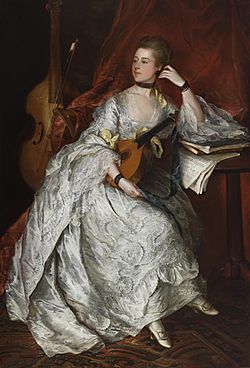Anne Ford facts for kids
Quick facts for kids
Anne Ford
|
|
|---|---|

Ann Ford (later Mrs. Philip Thicknesse) by Thomas Gainsborough, 1760
|
|
| Background information | |
| Also known as | Mrs. Philip Thicknesse |
| Born | 22 February 1737 |
| Died | 20 January 1824 (aged 86) |
| Occupation(s) | Musician and singer |
| Instruments | English guitar, viola da gamba, musical glasses |
Ann Ford (born February 22, 1737 – died January 20, 1824) was a very talented English musician and singer from the 1700s. She became well-known for her brave fight to perform music in public.
Contents
Ann Ford's Early Life and Music
Ann Ford was a gifted woman who lived in England during the 1700s. She received a better education than most people at that time. Ann knew five different languages. She also played several string instruments, like the English guitar and the viola da gamba. The viola da gamba is similar to a modern cello.
Ann used her musical skills to perform at private concerts. She would often play with others at her home on Sundays. However, her father, Thomas Ford, did not want her to perform for the public. He even had her arrested twice to stop her from performing.
Ann's First Public Concert
Despite her father's objections, Ann managed to escape his control. She held her very first public concert on March 18, 1760. This was a big step for her. After that, she performed many more concerts. She even gave daily shows from October 24 to October 30 that same year.
At the time, it was unusual for a woman to play the viola da gamba. Some people thought it was a "masculine" instrument. They called it the viol di gambo. But Ann played it anyway!
Playing the Musical Glasses
In 1761, Ann Ford gave a special performance at Spring Gardens. She sang "English airs" and played a unique instrument called the musical glasses. She also wrote a book titled Instructions for Playing on the Musical Glasses.
The musical glasses were like a glass harp. They were made of individual glass cups filled with water. Each cup was tuned to a different musical note. This instrument was played before Benjamin Franklin invented his famous armonica (glass harmonica) in 1761.
Standing Up for Herself
Ann's success was almost stopped by someone who admired her too much. This person offered her a lot of money to be his companion. When Ann refused, he tried to ruin her first public concert. But Ann was strong and still earned money from the show.
In 1761, Ann published a pamphlet (a small booklet) called A Letter from Miss F—d to a Person of Distinction. In it, she explained her side of the story. This led to another pamphlet being published in response.
Ann Ford's Later Life
On September 27, 1762, Ann married Philip Thicknesse. She became his third wife. This marriage helped her gain a higher social standing in society. They had a son named John Thicknesse, who later became a Captain in the Royal Navy.
Imprisonment in France
In 1792, Ann and her husband were traveling to Italy. This was during the French Revolution, a very chaotic time in France. Her husband suddenly died in Boulogne. Because she was a foreigner, Ann was arrested and put in prison.
She stayed in prison until July 1794. After the execution of Maximilien Robespierre, many prisoners were set free. Ann was released because she could prove she could earn her own living. Her musical skills helped her greatly.
Writing a Book
In 1800, Ann Ford published a book called The School for Fashion. This book was like a secret story. It included many famous people of her time, but with their names changed slightly. Ann herself appeared in the book as a character named Euterpe.
A famous artist named Thomas Gainsborough painted Ann Ford's portrait in 1760.

